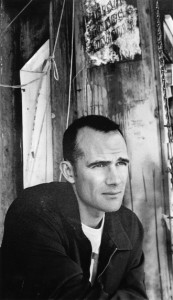 A few weeks ago I championed a recent trend of literary authors dabbling in television writing. I applauded novelists turned showrunners like Bored to Death’s Jonathan Ames for attempting to use “television to annually craft a novel in a different medium than the page.” So it caught my eye when the New York Times recently opened a short blog entry titled “Periodic Novel, Coming Soon,” with this: “Could people talk about books with the same timely intensity that they do the latest episode of ‘Mad Men’ or ‘Top Chef’?” The Times query was inspired by the announcement of House of Leaves scribe Mark Z. Danielewski’s forthcoming The Familiar, a 27-volume novel to be published a volume at a time every three months beginning in 2014. Danielewski’s editor, Edward Kastenmeier, claims that the books strive to fashion a “serial relationship” with readers, later elaborating: “You await the next one; you want to talk about it. Everybody will be engaging the book in roughly the same cycle.”Part of what makes Danielewski’s experiment interesting is precisely the competitive and comparative aspect with television that the Times hinges its notice on. Given the success with which programs of the HBO and AMC ilk have applied novelistic structure and characterization, with each episode and season simulating chapters and books, it will be fascinating to see how well Danielewski’s inversion (distributing a novel nearly at television’s pace) actually works.
A few weeks ago I championed a recent trend of literary authors dabbling in television writing. I applauded novelists turned showrunners like Bored to Death’s Jonathan Ames for attempting to use “television to annually craft a novel in a different medium than the page.” So it caught my eye when the New York Times recently opened a short blog entry titled “Periodic Novel, Coming Soon,” with this: “Could people talk about books with the same timely intensity that they do the latest episode of ‘Mad Men’ or ‘Top Chef’?” The Times query was inspired by the announcement of House of Leaves scribe Mark Z. Danielewski’s forthcoming The Familiar, a 27-volume novel to be published a volume at a time every three months beginning in 2014. Danielewski’s editor, Edward Kastenmeier, claims that the books strive to fashion a “serial relationship” with readers, later elaborating: “You await the next one; you want to talk about it. Everybody will be engaging the book in roughly the same cycle.”Part of what makes Danielewski’s experiment interesting is precisely the competitive and comparative aspect with television that the Times hinges its notice on. Given the success with which programs of the HBO and AMC ilk have applied novelistic structure and characterization, with each episode and season simulating chapters and books, it will be fascinating to see how well Danielewski’s inversion (distributing a novel nearly at television’s pace) actually works.
What makes the Times’ missive more intriguing, however, is how, well, familiar this model is to the novel’s history. Before dropping into readers’ laps in its current tome form, Anna Karenina ran as a serial publication between 1873 and 1877. Dickens serially published his entire oeuvre. More recently, Michael Chabon (another author soon to be occupying the small screen) crafted his short novel Gentlemen of the Road serially in the New York Times Magazine. And do we really have to stretch our minds to imagine Kastenmeier’s world in which readers are “engaging the book in roughly the same cycle” when that aptly describes how nearly everybody experienced Harry Potter?
Granted, some differences between these examples and Danielewski’s experiment are notable. Unlike the Tolstoy/Dickens/Chabon model, The Familiar will be released book by book, not nestled within the pages of journals or magazines with relatively cheap subscriptions. And unlike Harry Potter, which stretched its reading cycle with seven books over a decade, Danielewski’s installments will hit shelves at what the Times considers “a rapid timeline almost unheard-of in the publishing industry.”
Nonetheless, the Times question of “timely intensity” sells literature disappointingly short. That readers immerse themselves into longform serial narratives with the same dedication as Breaking Bad viewers isn’t something that’s ever gone away, nor does it appear to be endangered in the near future. That the newest crop of readers now don’t merely want, but seem to need, their favorite story’s next installments so hastily delivered, however, should inspire some real uncertainties.
This post may contain affiliate links.








